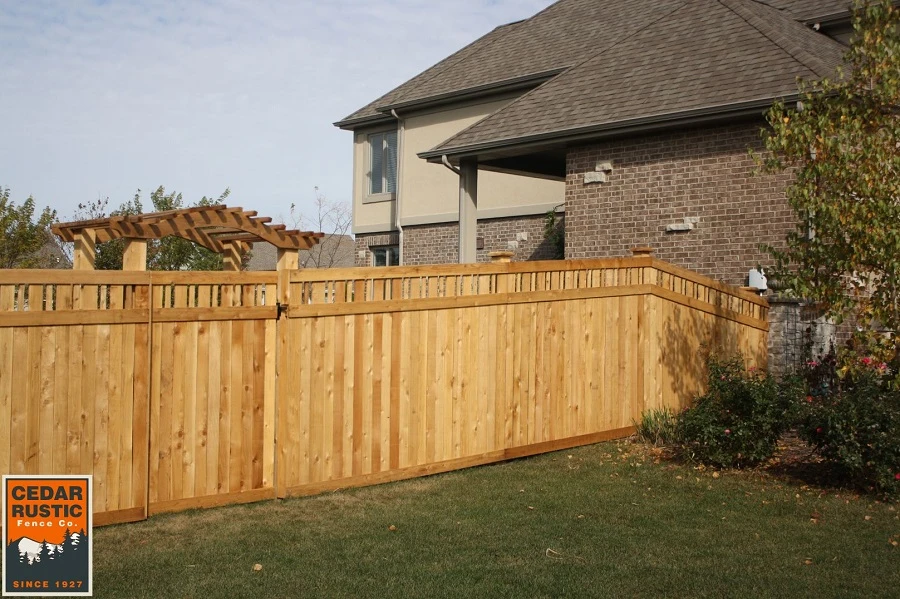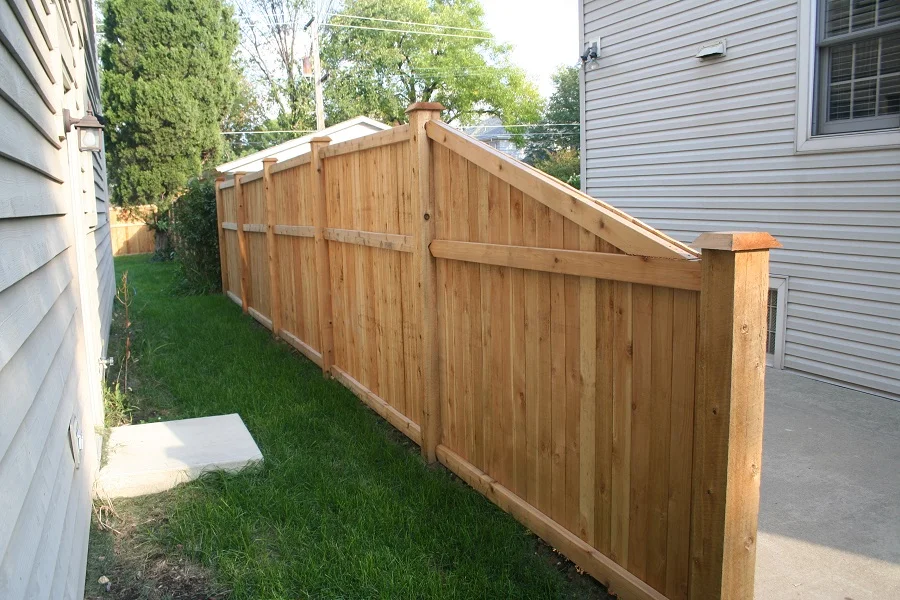Choosing the ideal fence for your property takes careful consideration. Two classic options, vinyl and wood, each have their own distinct pros and cons. As one of the oldest fence companies in Chicagoland with extensive experience in fence installation, we understand how significant it is for homeowners to choose the right option for their home. Let's dive into a comprehensive comparison of vinyl and wood fences, covering aspects like durability, appearance, maintenance needs, cost, installation, lifespan, environmental impact, and what best suits individual homeowner preferences.
Durability
A fence is an investment, and you want it to stand the test of time. Durability is vital for weathering the elements and providing reliable protection for your property.
.webp)
Vinyl Fence Durability
Vinyl fences have earned a reputation for their remarkable durability. Constructed from polyvinyl chloride (PVC), they are highly resistant to rotting, warping, and damage from insects. They also handle impacts well, making them an excellent choice for areas with unpredictable or harsh weather conditions. With proper installation and minimal upkeep, a vinyl fence can look fantastic for decades.
- 25+ years with no fading
- Zero rot guaranteed
- Pest-proof construction
- Withstands 70+ mph winds
- No cracking at -20°F
- Lifetime manufacturer warranty
Wood Fence Durability
Wood fences, especially those crafted from high-quality materials like western red cedar or northern white cedar can also offer good durability. Regular staining will preserve the color of the fence, but sealing isn’t necessary to safeguard the wood from moisture, rot, and insect infestations. A cedar fence lasts for 15 years and more or even longer with little to no maintenance.
- 15+ year lifespan
- Natural insect repellent
- Quick and easy repairs
- No rusting hardware
- 100% biodegradable
- Ages to silver-gray patina
Appearance
Your fence plays a major role in your home's overall curb appeal, so aesthetics definitely matter! Both vinyl and wood offer a range of styles to fit your tastes.

Vinyl Fence Appearance
Don't underestimate vinyl's versatility! It's come a long way, now available in a wide array of colors, styles, and textures — some even mimic the look of wood remarkably well. Whether you prefer classic white, modern grays or tans, or desire that natural woodgrain texture, vinyl has options for you.
Wood Fence Appearance
Wood fences are beloved for their timeless beauty and warmth. The natural variations in wood grain and color make each fence unique. And, wood takes stains or paint beautifully, letting you perfectly complement your home's exterior. Rustic split-rail designs, elegant privacy fences... wood offers them all.
Maintenance
Upkeep is essential to ensure your fence not only lasts a long time but also maintains its good looks. Let's delve into the differences between vinyl and wood maintenance requirements.
Vinyl Fence Maintenance
Vinyl fence is known as a maintenance-free fence. To keep your vinyl fence looking its best, a simple rinse with the garden hose to remove dirt and debris is usually all it takes. For more stubborn stains or mildew, a mild detergent and a soft-bristled brush will do the trick. Should any damage occur, vinyl fences repairs tend to be straightforward, with many manufacturers offering readily available replacement parts.
Wood Fence Maintenance
Wood fences are beautiful, and don’t require much maintenance. Regular power washing can be done if you’re looking to stain the fence to preserve its color. If you choose a painted wood fence, be prepared for periodic repainting to keep it looking fresh. And, always replace damaged or rotted boards promptly to prevent further deterioration and maintain the fence's structural integrity.
Cost
The cost of a wood or vinyl fence extends far beyond the day it's installed. It's vital for homeowners to factor in long-term expenses when choosing a material.
Vinyl Fence Cost
Yes, vinyl fences typically have a higher upfront price than wood, averaging $25 to $50 per linear foot with installation included. However, its exceptionally low maintenance needs and impressive lifespan help balance that out. You'll save significantly on staining, sealing, and repairs over the years.
Wood Fence Cost
Wood is the budget-friendly choice, averaging $20 to $40 per linear foot installed. It requires little to no maintenance, unless you want to stain it to maintain a certain color. Overall, wood is a the great way to keep costs down, maintain a beautiful aesthetic, and protect your home.
Price Comparison
When you’re evaluating the cost-effectiveness of wood versus vinyl fencing, it's important to consider both short-term and long-term expenses for these fence materials. It's also worth exploring various fence installation options to find the right balance between quality and affordability for your specific property needs.
Installation
Installing a fence can be quite a project, with the difficulty varying based on material and your chosen design.
Vinyl Fence Installation
Most vinyl panels are pre-assembled, significantly reducing the time and labor involved. The most important part is ensuring the fence posts are set correctly and perfectly plumb. After that, attaching the panels follows the manufacturer's straightforward instructions. Vinyl is not as easily customizable as wood.
Wood Fence Installation
Wood fence installation offers two construction methods:
- Stick build: You set the posts, attach the cross rails (2x4’s), and then nail the pickets onto the cross rails. This method is labor-intensive in the field but allows for a high degree of customization.
- Panel build: You set the posts and then attach finished sections or fence panels to the posts. This method is less labor-intensive in the field and offers more variety in fence patterns you can construct.
Lifespan
Choosing a fence means choosing how long you want to enjoy it without major replacements or repairs. Let's see how vinyl and wood stack up in terms of longevity.
Vinyl Fence Lifespan
Vinyl is a champion of durability. If installed correctly and given basic care, a vinyl privacy fence can easily remain in excellent condition for over 20 years. Most reputable vinyl fence manufacturers offer a lifetime warranty on the fence material. It's important to read the fine print, as some warranties cover the expected lifetime of the fence, which could be 15 years, while others cover the lifetime of the original purchaser as long as they still own the property. Its tough PVC construction shrugs off fading, weather damage, and everyday wear and tear. Even after many years of sun and rain, a vinyl fence often looks remarkably close to how it did when new.
Wood Fence Lifespan
The lifespan of a wood fence is more variable, depending on the type of wood, how well it's installed, and the level of care it receives. Generally, a well-maintained wood fence can provide a good decade or more of service. However, neglecting staining, sealing, and repairs invites trouble. Moisture, harsh sunlight, and insects can rapidly degrade a wood fence, shortening its lifespan. Selecting the best wood for fence construction plays a crucial role in maximizing its durability, with cedar typically outperforming many other wood varieties in outdoor applications.

Homeowner Preferences
The best fence is the one that perfectly aligns with your priorities. Let's consider what might drive a homeowner toward vinyl or wood.
Vinyl Fence Preferences
If you crave minimal upkeep and want your fence to look good for decades, vinyl is a compelling choice. Its resistance to the elements and lack of painting or staining needs are major draws. The wide array of vinyl colors and styles makes finding a perfect match for your home's aesthetic easy.
Wood Fence Preferences
Nothing beats the timeless charm and natural beauty of wood. Its warmth and character add instant appeal. Wood also offers fantastic customization potential — stains, paints, and the ability to modify the design to suit homeowners who like putting their personal stamp on their property. If you enjoy the satisfaction of DIY projects, wood fences are more readily repairable or modifiable than vinyl.












